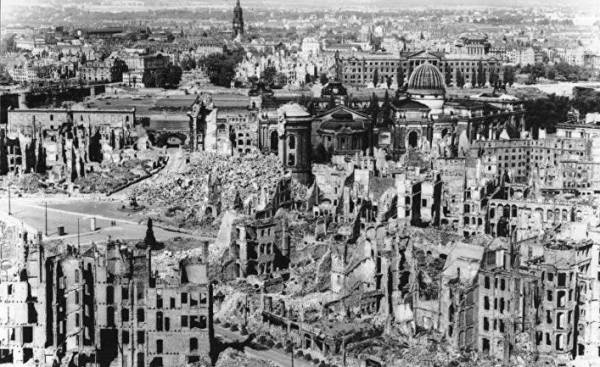
Operation to rout the city, in fact, ended. And actually, early on the morning of 14 February 1945, in Dresden there was nothing left to destroy. After all, at about 4 a.m. a fire storm started by 759 British bombers was rampant with maximum power. It was held in two stages, during which it was dropped 1472 tons of high-explosive bombs and 648 586 tons of thermite incendiary bombs in between 22.03 22.28 h and eve, and between 1.30 and 1.55 h
However, the “ash Wednesday” a few hours before sunrise was woken up by the crews of the 8th air army of the United States. Boeing “b-17” in the amount of 431 aircraft ordered to attack Saxon residence of the German monarchs. Sergeant William Stewart, air gunner, had Breakfast of bacon and eggs, and then began the discussion of the operation. He didn’t know where flew: “I don’t remember someone said something about Dresden”, he said 30 years later: “the Flight was scheduled at 7 o’clock in the morning.”
A concerted attack on the same targets that the British bomber units were at night, and American planes in the daytime, no longer was anything unusual. Here’s what followed a monstrous calculations: the second attack hindered the carrying out of works on liquidation of consequences of the first attack; in a perfect “military” case is especially pronounced losses were in the special forces of the enemy, such as fire and rescue services, and thereby increased the total inflicted on the enemy damage. War is almost always cruel.
Although not every significant goal had been subjected to attacks carried out under the scheme, cities like Berlin, Hamburg or Essen has experienced some of these coordinated attacks. No sound principle was not here: it all started with the “carpet” bombing by the British air force carried out unarmored and low-flying “Lancaster”, then — at least theoretically — more sighting daytime attacks of the US air force perpetrated by flying higher and having the best defense Boeing “b-17”.
Dresden, in fact, even in the afternoon of 13 February 1945, was to attack the forces of the 8th air army of the United States, but the weather made the plans their own adjustments. Thus, the first attack was made by the British and by night the city centre was on fire before the attack was followed by “flying fortresses” of the Americans.
Officially, the purpose of the attack was a marshalling yard station, Dresden had strategic importance. The elongated shape the station area is located North-East from the Central station, in the outskirts of Dresden Friedrichstadt, and was so extensive that even a small cloud can be detected by optical instruments and by ground-based radar H2X, which had a not too high resolution.
However, it was rather a formal character, as some commanders have given their pilots only a formulation of the object of the attack, as “Dresden”, and some “military targets in Dresden”. Brigadier General Howard M. Turner, commander of the 1st bomber division, called for the purpose of “centre of built-up area of Dresden”.
At least it was honest: because of the smoke after the fire storm the city center in the afternoon of 14 February 1945 was hardly visible from the air. Between 12.17 and 12.23 290 “flying fortresses” bombed Dresden, and another 21 aircraft, behind tier bombers raided between 12.29 and 12.31, the remaining bombers were sent the other way or went astray. In total, the day of “ash Wednesday” on Dresden was dropped 470 tons of high explosive and 136.800 tons of incendiary bombs.
However, a daily attack Americans eyewitnesses recalled and continue to be remembered only as myth about the “hunt” for civilians of the American fighter escort. The Commission of historians on behalf of the city in 2010 engaged in a detailed study of the air attacks, came to the conclusion that the 14th of February 1945 there were no such attacks in the centre and on the banks of the Elbe, in contrast to the bombardment on the way back of the aircraft and in the open area, where low-flying American planes had to attack it “random targets”.
Since all simply rested on fundamentally impossible proof for attacks from a low height, bombing Americans is hardly given importance. This is understandable from a psychological point of view: experience of a fire storm greatly traumatized consciousness of the survivors, and since in downtown in many places is still raging fires, the witnesses were unable to distinguish British from American attack.
It is also impossible to determine how many of 22-25 thousand dead reported by the Commission of historians, were victims of three large-scale attacks of the British, and how many perished in the attacks of Americans. Still, this distribution of victims does not matter. Most of the inhabitants of Dresden, save the muffled roar of the powerful radial engines didn’t understand this approaching air of mortal danger. Clouds almost completely covered the sky, bombs were thrown, “based on the evidence of radar”, as he wrote in his report about the operation commander 303й bomber group.
Goetz Bergander, 18 years old, a former “assistant Luftwaffe air defense” and who witnessed the destruction of his native city, recalled: “Our house shook so much, and then a long time, something rattled, rustled and crackled, I thought that the house was bombed that he is gone.” When the beats carpet bombing could be heard already in the distance, Bergander went upstairs: “To my surprise, the house still stood — he was well-built in 1900-ies, with walls a metre thick”.
14 February 1945 was mainly destroyed the garage, but the area Loebtau suffered from a lot of bombs. However, the attacks have not led to a new fire storm, as it was in the previous night. Probably, this development was too rare.
In the final report of the 8th air army of the USA on the day of the attack said: “Dresden — unidentifiable or mediocre results.” According to residents of Friedrichstadt, the results looked completely different. However, on this episode of attack of the allies on Dresden today is almost forgotten. After the demolition of the city at that time, in fact, has already been completed.







